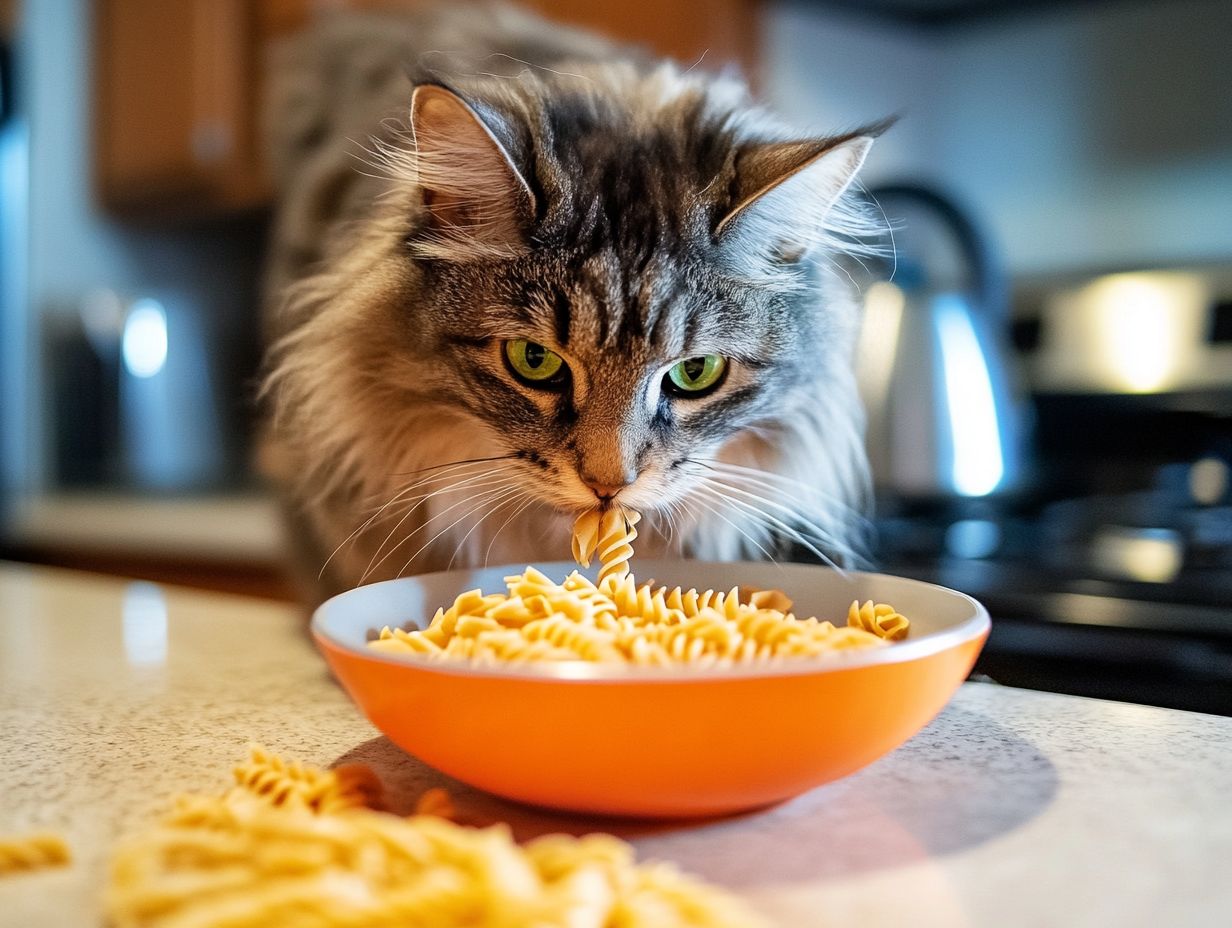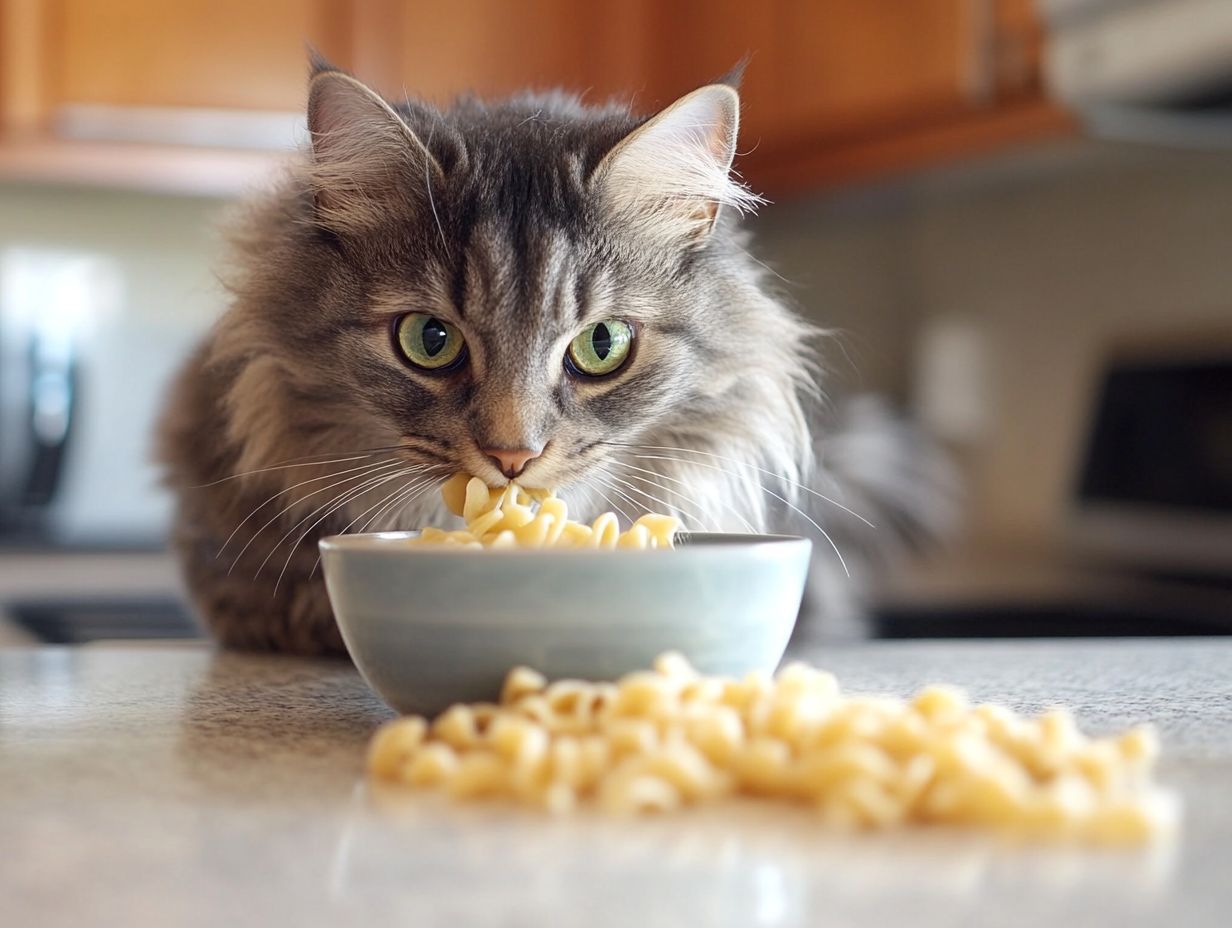When it comes to feeding our feline friends, understanding their dietary needs and consulting a veterinarian is crucial. Many pet owners wonder whether cats can safely consume cooked pasta. While it may seem harmless, there are important benefits and risks to consider. This article explores the nutritional essentials for cats, the implications of pasta in their diet, and healthier alternatives to ensure your pet thrives. Consulting a veterinarian provides insights into the proper dietary guidelines for your cat’s overall wellness.
Key Takeaways:

- Cats have specific nutritional requirements that should be met through a balanced diet, including high-quality protein sources and essential nutrients.
- In moderation, cats can safely consume cooked plain pasta as a treat, but it shouldn’t be a regular part of their diet since it lacks essential nutrients.
- Feeding pasta to cats can lead to health issues like obesity, digestive problems, and nutrient deficiencies; stick to cat-specific foods and treats, and monitor weight gain to prevent obesity-related issues.
Overview of Cats’ Dietary Needs
Cats are obligate carnivores and need a diet high in animal protein to maintain their overall health and well-being. Essential nutrients such as taurine, fatty acids, vitamins, and minerals are also vital for a cat’s diet. To ensure that their pets receive appropriate nutrition, cat owners should consult a veterinarian for dietary guidance, especially regarding food allergies.
Understanding Cats’ Nutritional Requirements
Cats require a balanced diet rich in proteins, vitamins, and minerals to maintain their health and quality of life. As obligate carnivores, their nutritional needs differ significantly from those of other pets.
- Proteins: Cats’ diets should primarily consist of proteins from animal products. A high-protein diet is essential for maintaining muscle mass, providing energy, and promoting growth.
- Vitamins: Essential vitamins such as A, B, and E boost the immune system, promote healthy skin, fur, and vision, and support growth. They also regulate metabolic functions, reduce oxidative stress, and help eliminate toxins.
- Minerals: Essential minerals like calcium and phosphorus are vital for bodily functions, with calcium and phosphorus crucial for bone formation and sodium and potassium assisting in the transmission of nerve impulses. Iron is important for hemoglobin formation, facilitating oxygen transport and supporting overall health.
To ensure that cats remain nourished and enhance their quality of life, their diet must be tailored to their species, age, and size. Regular veterinary care is essential for managing dietary needs.
Pasta in Cats’ Diet
Feeding pasta to cats is not common; however, it’s crucial for pet owners to understand how this food fits into a cat’s specific dietary requirements. Always consult a veterinarian before introducing new foods.
Can Cats Safely Consume Pasta?

Cats can safely eat pasta, but several factors influence its suitability, including the type of pasta, how it is prepared, and the quantity offered. As obligate carnivores, cats require protein to maintain their health; therefore, pasta should only be given on special occasions and should never replace their essential protein intake. Limit pasta to a small piece (no larger than a teaspoon for a small cat) as an occasional treat, and always monitor for any adverse reactions. The pasta should be plain and unseasoned to avoid gastrointestinal issues. To learn more about this, check out Can Cats Eat Pasta? Safe or Harmful?.
Feeding more than a small piece of plain pasta (about the size of a penny) is generally unsafe as a treat. Be aware that potential health issues may arise from feeding pasta, such as obesity or digestive problems.
In conclusion, while cats can have pasta occasionally, it’s important to prioritize their nutritional needs and provide a balanced diet tailored for their health.
When offering pasta, it should be plain and unseasoned, as sauces, spices, flavorings, and additives can lead to digestive issues or even toxicity in cats. Always monitor your cat for any adverse reactions to new ingredients and keep the portion size small.
Potential Risks of Feeding Pasta to Cats
Pasta can be an occasional treat for cats; however, it is essential to understand the potential risks associated with feeding pasta to them, considering their health and dietary needs. Improperly feeding pasta can lead to gastrointestinal issues such as diarrhea and vomiting. For more information, refer to resources from the American Veterinary Medical Association (AVMA) on feline nutrition and the specific risks associated with feeding cats pasta.
Possible Health Consequences
Feeding pasta to cats can lead to various health consequences, including gastrointestinal issues such as diarrhea and vomiting if not done properly. Cats primarily eat meat; their bodies are designed to break down animal proteins rather than the carbohydrates found in foods like pasta. Introducing high-carbohydrate diets can upset their stomach and lead to weight gain.
Additionally, if cats have an allergic reaction to the non-meat ingredients in pasta, they may experience symptoms such as itching, swelling, and respiratory problems. Digestive issues can also include bloating and pancreatitis, as cats’ digestive systems are not equipped for high-carbohydrate diets. If these symptoms occur, such as difficulty breathing or swelling, consult a veterinarian promptly.
These symptoms highlight the importance of providing a species-appropriate diet to maintain the overall health of cats. Proper veterinary care and regular wellness checks ensure your cat receives the best nutrition.
Alternatives to Pasta for Cats
Nutritious alternatives to pasta for cats consist of various foods that provide healthy and balanced meals. These alternatives should be rich in animal protein and low in carbohydrates to suit their dietary needs.
Nutritious Options for Cats’ Meals

Nutritious meal options for cats include lean meats, such as grilled chicken, turkey, and fish, along with select vegetables and specially formulated cat foods that cater to their dietary needs. Incorporating lean proteins is essential, as these provide the necessary building blocks for maintaining a strong and healthy body. Offering grain-free options can also help in avoiding gastrointestinal issues.
Introducing safe vegetables like carrots and peas can enhance the fiber content of their diets, aiding in digestion. Additionally, offering grain-free kibble or wet foods rich in essential nutrients can be beneficial. Regular consultations with a veterinarian for dietary advice can ensure your cat’s overall wellness.
By providing a variety of meal options, cat owners can promote overall well-being and vitality, making mealtimes not only nutritious but also enjoyable for their feline companions.
Safe and Unsafe Foods for Cats
- Safe Foods:
- Lean meats (chicken, turkey, fish)
- Carrots
- Peas
- Commercial cat food
- Unsafe Foods:
- Pasta with sauces
- Onions
- Garlic
- Chocolate
Frequently Asked Questions
Can Cats Eat Pasta?
Yes, cats can technically eat pasta, but it is not recommended as a regular part of their diet.
Is Pasta Safe for Cats?
In small quantities, pasta is generally safe for cats to eat. However, it should not be a staple in their diet.
What Types of Pasta Can Cats Eat?

Plain, cooked pasta without any added sauces or seasonings is the safest option for cats. Avoid giving them pasta with garlic, onion, or other potentially harmful ingredients.
Why is Pasta Not Recommended for Cats?
Pasta is not a natural part of a cat’s diet and does not provide the necessary nutrients and proteins they need. It can also lead to digestive issues and weight gain in cats.
Can Cats Develop Allergies to Pasta?
While cats can occasionally consume small amounts of plain pasta, it’s important to be aware of potential allergies and to monitor their health closely. Cats can develop allergies to certain types of pasta, such as wheat or gluten. It is essential to monitor your cat’s reaction to new foods and consult with a veterinarian if you notice any unusual symptoms.
What Should I Do if My Cat Eats Pasta?
If your cat accidentally eats a small amount of plain pasta, it is unlikely to cause any harm. However, if they consume a large amount or show any signs of distress, such as vomiting or diarrhea, it is best to contact your veterinarian for advice immediately.
Benefits of Pasta for Cats
While pasta can be a source of carbohydrates, it is crucial to note that cats are obligate carnivores and do not require carbohydrates in their diet. Therefore, any benefits are minimal and should not outweigh the potential risks.
Common Symptoms of Pasta Allergies in Cats
- Skin irritations
- Gastrointestinal upset
- Vomiting
- Diarrhea
Risks of Feeding Pasta to Cats
Although a small amount of plain pasta is usually safe, it should never be a regular part of their diet due to its high carbohydrate content, which can lead to obesity and other health issues.
Guidelines for Safe Feeding
- Limit pasta to a small portion, no larger than 5% of their daily caloric intake.
- Introduce new foods gradually, starting with a small taste.
- Monitor your cat for any adverse reactions for 24 hours after introducing new foods.
Conclusion
Always consult your veterinarian before introducing new foods to your cat’s diet, and keep an eye on their health for any adverse reactions. Prioritize a balanced diet tailored to your cat’s needs to ensure a safe and healthy feeding experience.